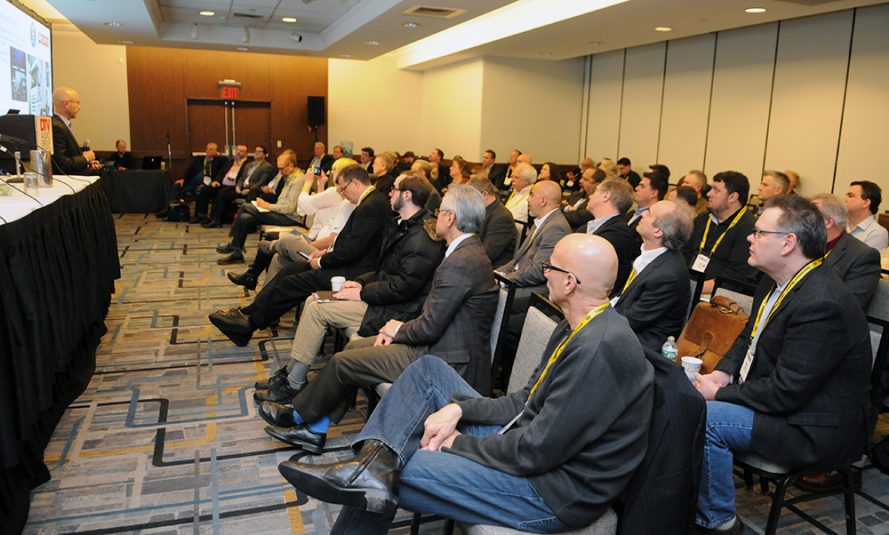SVG Summit 2017: RF, IP Are Primary Focus in DTV Audio Group Sessions
New standards, spectrum repack, at-home production mark a changing industry
Story Highlights
The DTV Audio Group’s Audio Production and Distribution Workshop led off the audio side of this week’s SVG Summit. Although RF spectrum issues, a primary focus of the DTVAG’s constituency for much of the last two years, were still front and center, the imminence of object-based broadcast audio and new standards around IP-based transport also were high on the agenda. Those included the nascent implementation of ASE67 and the SMPTE ST 2110 suite of standards.
The shift to the ATSC 3.0 set of broadcast standards, which include Next-Generation Audio, is taking place even as the RF-spectrum repack swirls around it, underscoring the disrupted environment that broadcast audio is experiencing. The Audio Engineering Society’s Audio Guidelines for Over-the-Top Television and Video Streaming (AGOTTVS) was referenced early in the program. The project, which focuses on loudness guidelines for OTT and OVD content, released an update on its progress several weeks earlier. Although the CALM Act did indeed resolve many of the loudness issues that broadcast television faced following the shift to digital broadcasting, the migration to an IP-based distribution model raises its own set of loudness concerns.
The Consumer Technology Association (CTA, formerly the Consumer Electronics Association), is working on developing standards for the products that consumers will use in the home to interface with new immersive audio systems and that will allow consumers to personalize the experiences that object-based audio and IP distribution can offer. These include such capabilities as hybrid commentary, in which broadcast and streamed content can be reliably synchronized to allow viewers to dial in local and regional commentary for national and international games, as well as being able to vary the balance between commentary and effects audio channels.
RF was never far from the top of the list of items under scrutiny during the Summit. The rapid rollout of spectrum acquired by mobile-service vendors in the wake of the FCC’s spectrum auction, concluded earlier this year, was illustrated on a national county map, which showed that areas of the U.S. West are experiencing especially quick rollouts, which can affect wireless-microphone operations at events, including sports events.
A representative of a market-research firm looking at consumer receptivity for object-based broadcast-audio features noted that, although “the quality of audio is of great importance to televised-sports viewers,” the emphasis on audio increases among “super fans,” who represent about a quarter of viewers.
Dolby’s Atmos, the primary Next-Generation Audio format in the U.S., is now being applied to NHRA shows. Training on Atmos technology and techniques is being accelerated, through an online program developed for Dolby by the Conservatory of Recording Arts & Sciences.
The future is also expected to see more in the way of extended remote production, also called at-home or REMI production. Sennheiser revealed some of the beam-steering technology it’s now working on, which will automate sound capture on the field with the goal of making “all player sound available all the time.” That will join Lawo’s KICK ball-tracking system, already in use by a German football broadcaster and league.
Because of many of these new platforms for sports will rely on wireless communications, the focus kept returning to what has become a considerably disrupted RF landscape, one in which uncertainty remains a major problem. Alteros’s Jackie Green said she is glad to see the industry moving away from the UHF frequencies, which she described as this “risky, contentious band.” But she also acknowledged that the future will be a messy one when it comes to where wireless will live, ranging from the VHF range well up into the GHz stratosphere.
RAD’s Geoff Shearing opined, “The future will be a real mix of bands and approaches, even on the same show.”
The emphasis in the discussions remained firmly on the future. Several new products presented during the panels underscored how the AES67 and ST 2110 standards are changing fundamental platforms for broadcast audio, such as the shift away from matrixed-based routing architectures, which will be limited not by conventional I/O availability but by multicast addresses, which can reach into the tens of thousands
“As broadcast engineering becomes IP based, it’s now all about scalability; distance goes away,” said DTVAG Executive Director Roger Charlesworth. “[IP] is broadcast’s new lingua franca.”

